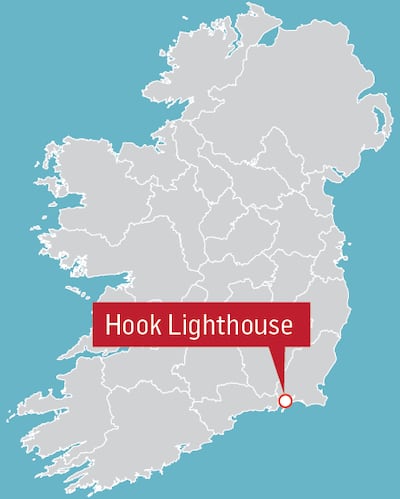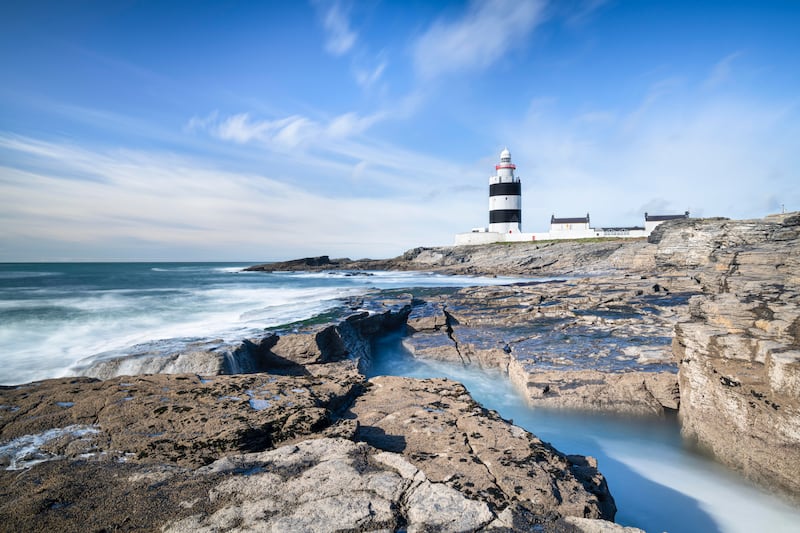For centuries, Ireland’s lighthouses have stood strong against raging storms, offering a beacon of hope for sea travellers and carrying a strange fascination for those on land. In a new series, The Irish Times visited some of Ireland’s most notable lighthouses, including Blacksod, Fanad, Ballycotton, Hook, and Wicklow Head, to learn about their fascinating histories and how their roles have changed in the modern era.
Winding through the innards of Hook Lighthouse in southwest Co Wexford on an overcast Thursday, tour guide Jon Pearce is brimming with knowledge and folklore, showing a true passion for the place.

“The Hook lighthouse is the oldest fully intact and fully operational lighthouse anywhere in the world,” he says proudly. “This tower that we are going to go up into is 800 years old, but there has been a signal fire here on the Hook peninsula since the fifth century. That was started by monks who came across from Wales and by one in particular, Dubhán, to keep this place safe for ships and sailors.”
For those who grew up in south Wexford, a drive to “the Hook” was one of those things you did some Sunday afternoons. But the origin of the name wasn’t something you would necessarily have thought about.
READ MORE
“If you translated St Dubhán’s name from old Irish back into English,” says Pearce, “it actually meant ‘fishing hook’ or the point of a hook, and that’s where the Hook peninsula gets its name.”
The white lighthouse tower, wrapped by two distinctive black stripes, stands 36m high and the walls are three or more metres thick. They are required, given the lighthouse is exposed to choppy waters due to currents from the Celtic Sea, St George’s Channel and the Atlantic Ocean mixing at Waterford Harbour estuary and meeting the push of the ‘three sisters’ – the rivers Nore, Suir and Barrow – as they flows outwards.
Add in strong winds, changeable weather, fog and occasional storms and this, our guide states, “suddenly becomes one of the most dangerous places to sail around on the planet”.
“There are only two places that will beat the Hook lighthouse for danger, and you’ve heard of these two, one is the Cape of Good Hope in South Africa and the other is Cape Horn in Chile,” says Pearce.
“To give you the paperwork on that, so you don’t just think I am telling you a story, from the Hook lighthouse all the way over to Kilmore Quay and the Saltee Islands, all this coastline is known as ‘The Graveyard of 1,000 Ships’. But there’s more than 1,000 ships in that graveyard.”
The mission of sparing people from these dangers has remained the same here since St Dubhán and company began lighting fires 1,500 years ago. The Vikings saw the beacon’s value and, surprisingly enough, left the monks to it while coming and going as they established Waterford city in the 10th century. In the early 1200s, William Marshal, the lord of Leinster and son-in-law of Anglo-Norman nobleman Strongbow, was in charge of the region as the monks used the peninsula’s limestone to build the existing tower with a view to better protecting what had become a valuable shipping channel.
Glass was put around the coal fire in the 1670s to better protect the warning light after a series of shipwrecks. In 1791 the beacon started to be lit by a whale oil-powered lamp and soon after the lighthouse was garrisoned by soldiers from nearby Duncannon Fort during the 1798 rebellion.
The operation became a bit more formal thereafter, with lighthouse keepers being appointed. A roll of honour hanging inside lists Daniel Kirwan (1810) as the first.
The lighthouse switched from oil to gas power in 1871 and then, in 1910, a mechanism was added to change the beacon from a fixed to a flashing light. Electricity, or “electrickery” as some sceptics here called it, arrived in the early 1970s. In 1996 the operation was fully automated and the last principal keeper, Thomas “Tucks” Tweedy, whose father and brother’s names also appear on the roll, stood aside.
As he points out a uniform once worn by the lighthouse keepers, Pearce explains his admiration for those who took on the responsibility over more than 170 years of trying to keep our forebears safe as they ventured off to new worlds.
“My connection to these people is that my partner, Fiona, was in the lifeboat service for 16 years,” he says.

“Tucks Tweedy, the Irish lighthouse keepers, the men and women from Fethard-on-Sea, Dunmore East, Kilmore Quay, Helvick Head – when something goes wrong, and it’s a great Irish thing, everybody gets on board and helps out. I cannot tell you the searching that these people did, daytime and night-time, for sometimes lost causes.
“In the old days, proper heroes were measured by the number of lives they had saved. Every man and woman who ever wore this uniform are my heroes.”
Rory McGee, operations and engineering manager with the Commissioners of Irish Lights, which oversees Ireland’s maritime navigation network, says the technology has changed but Hook and about 60 other lighthouses dotted around the coast “still do exactly the same job – they still provide the same reassurance they always did”.
“These days with modern electronic navigation, the lights themselves are more of a reassurance, a backup in case things go wrong, because they can and do go wrong, but you’ll always have a lighthouse to get you home safe,” he says.
Like many things, the lighthouse network is going through a modernisation programme, with an aim of becoming more environmentally friendly. At Hook, says McGee, LEDs now illuminate the Fresnel lens in the beacon, which has a range of 18 miles and flashes once every three seconds at night as its unique marker.
Automation has left Ireland’s lighthouses with more capacity to open to the public. The former keepers’ homes have become a visitor centre, restaurant and gift shop at Hook, and it appears to be working. The car park is dotted with buses and cars bearing UK, Italian, German and Dutch plates. Tour groups flow up and down the tower’s 115 steps.
The guestbook features messages left by visitors from four continents, with one US couple writing; “Incredible to see 800 years of history!”
Elaine Wallace, one of the centre’s management team, says 220,000 people, nearly three-quarters of them Irish residents, visited last year.
An aim of the operation is to provide jobs for people in a remote community where protecting the coastline, a significant employer through tourism and fishing, is important. Asked what the lighthouse means to locals, Pearce, who lives on the Hook peninsula, says “an awful lot”.
“I look out of my window every evening and I can see that light flashing. Fiona, my partner, is a fisherwoman here. She’s fished with her dad since she was 14 years of age ... Every time she looks over her shoulder on her boat and can see the Hook lighthouse standing there, she knows that’s her way home, she knows she’s safe. It is more than just a building.”
“If I won €3 million on the lotto, I would not sell my house and move away from Hook because I would miss this place. I wouldn’t be right unless I looked over my shoulder and saw that light shining there.
“It can be a beacon, a family beacon, a guiding light ... It is part of our history and I am so glad to live beside Hook lighthouse.”
On Monday, Arthur Beesley visits Fanad Head lighthouse on the northern shores of Co Donegal
- Sign up for push alerts and have the best news, analysis and comment delivered directly to your phone
- Join The Irish Times on WhatsApp and stay up to date
- Listen to our Inside Politics podcast for the best political chat and analysis



















